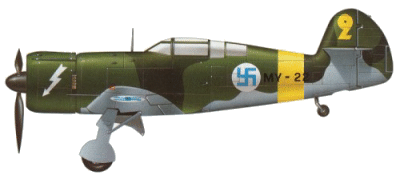
Finland decided to
develop an indigenously built fighter that had better performance than
the license-built D. XXI prior to the Winter War, but that conflict
forced any such efforts to be postponed. Development began in earnest
after the end of the Winter War and the first flight was on 23 December
1941. Not surprisingly for a first effort the Mysrsky (Tempest)
suffered from many teething problems that included wing failure in a
dive and compression problems that resulted in the port elevator being
torn off in a dive. A number of structural modifications had to be made
to aircraft on the production line that further delayed its
introduction into service. The three pre-production aircraft were
referred to as the I series and the remaining 47 aircraft on order
comprised the II series. 14 of these were completed by the end of July
1944 and another 16 by the Armistice on 4 September with production
being completed by 30 December. An additional batch of ten had been
ordered as Myrsky IIIs in early 1944, but this was cancelled after the
Armistice. Fifty were built in two production variants by Valtion
Lentokonetehdas, the state aeronautical industry founded back in 1928.

A Myrsky II 26 HLeLv (Fighter Group) Finnish Air Force - Kemi Finland
1944
The project, entrusted
to E. Wageluis, the technical director, was launched in 1941, and
appeared in the form of a prototype the following year. It was a low
wing monoplane with retractable rear tricycle landing gear, a wood and
metal airframe and covering and a Swedish version of the Pratt &
Whitney SCG-3 Twin Wasp built on license and capable of generating
1,650 hp (794 kW). The armament planned consisted of four machine guns
installed in the fuselage, synchronized to fire through the propeller
disc.
The first prototype was
followed by three pre-series aircraft, designated Myrsky I, and
together these were submitted to tests and initial evaluations which
lasted for a lengthy period. In fact, there were many structural
problems which the technicians had to solve before creating the
definitive production version, the Myrsky II. The wings' composite
covering tended to become detached under strong pressure. In addition
the main landing gear proved to be dangerously weak and the joinings of
the half wings showed signs of giving way, making it necessary to
redesign them completely, as well as to reinforce the whole wing
structure. In fact, due to these problems (to which was added a
pronounced lateral instability during flight testing), all four initial
aircraft were destroyed during flying accidents, and consequently, the
timing of the entire production program was subject to serious delays.
All the modifications
which originated from the test flights were incorporated into the
production version, 46 of which were built during 1944. However, the
Myrsky II went into service too late to contest the Soviet offensive
against Finland. The rapid evolution of the conflict and the peace
treaty stipulated in September 1944, led to a drastic change in the
scenario and the Finnish fighters were employed against their
ex-allies, the Germans, above all in the role of tactical support. In
combat the Myrsky was not particularly successful, and moreover did not
meet with the full approval of its pilots.
Prior to September
1944, a new version of the fighter had been prepared, with the aim of
improving the aircraft's mediocre performance. It was designated Myrsky
III and ten were put into production. However, they were never
completed.
The Myrsky's
performance didn't compare to the Bf 109G's and it wasn't wanted by the
fighter units, especially considering all its structural problems
during flight testing. Reconnaissance units were desperately short of
aircraft and TLeLv 12 received some 20 aircraft before the Armistice.
It flew 66 sorties before that date with no losses recorded and only a
couple of Soviet fighters claimed damaged. TLeLv 16 also received 6
Myrskys before the Armistice, but wasn't yet operational when it took
effect. TLeLv 12 flew reconnaissance missions against the Germans in
Lapland, but no combat resulted, with only one Myrsky being lost in a
landing accident.
Specifications (Valtion
Lentokonetehdas Myrsky)
Type: Single Seat Fighter
Design: E. Wageluis as
Technical Director
Manufacturer: Valtion
Lentokonetehdas (State Aeronautical Industry)
Powerplant: One 1,065
hp (794 kW) SFA-SCG-3 14-cylinder air-cooled radial engine which was a
licensed version of the Pratt & Whitney R-1830 Twin Wasp.
Performance: Maximum
speed 328 mph (529 km/h) at 10,690 ft (3250 m); maximum speed 292 mph
(470 km/h) at sea level; initial climb to 19,685 ft (6000m) in 10
minutes.
Range: 579 miles (933
km) on internal fuel.
Weight: Empty equipped
5,479 lbs (2485 kg) with a maximum take-off weight of 7,085 lbs (3213
kg).
Dimensions: Span 36 ft
4 in (11.00 m); length 27 ft 5 in (8.35 m); height 9 ft 10 in (3.00 m);
wing area 193.752 sq ft (18.00 sq m).
Armament: Four 12.7 mm
(0.50 in) LKK/42 machine guns plus provisions for two 220 lbs (100 kg)
bombs.
Variants: Myrsky (one
prototype), Myrsky I (three pre-production), Myrsky II (47 production),
Myrsky III (10 ordered but never completed).
Avionics: None.
History: First flight
(prototype) 23 December 1941.
Operators: Finland. |
